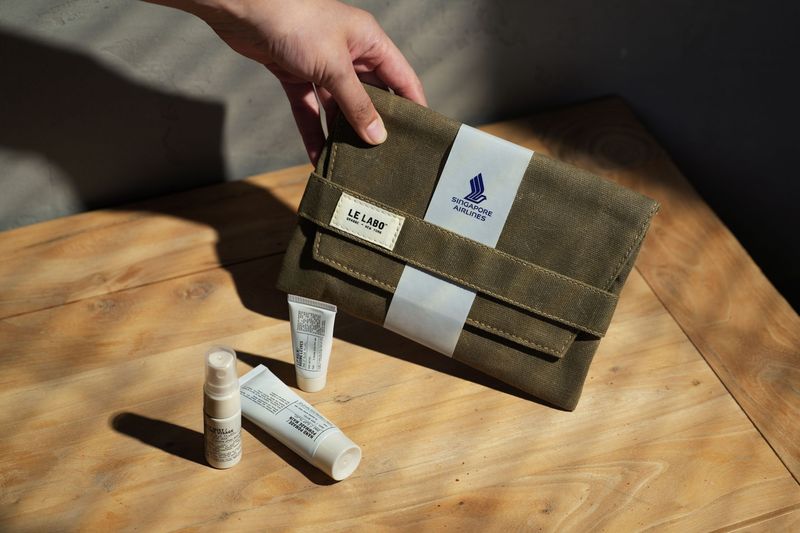


Singapore Airlines wants you to reuse their amenity kit after your flight.
The company has many sustainability initiatives, including scaling its use of sustainable aviation fuel, optimizing its routes for fuel efficiency and reducing its energy usage in ground operations. But the airline said that making its amenity kits last past the flight is another way to keep its operations eco-friendly.
“One of the things that we see across the company now is that sustainability is top of mind, but we balance that with what our customers expect, with what they need.” Timothy Chua, Singapore Airlines’ Vice President of Lounge Development and Inflight Operations, told USA TODAY in an interview. “At all times, we deliver something that is helpful and well-considered.”
Across the industry, airlines have been making efforts to reduce their carbon footprints as well as their waste production in their operations. Companies try to strike a balance between minimizing waste from onboard services like amenity kits and food and beverages, while also making sure passengers have everything they need to stay comfortable, especially on long-haul flights.
Many U.S. airlines with long international routes also provide amenity kits on long-haul flights, most commonly overnight flights to overseas destinations. These are often available even in economy, though the specific kits usually vary by class of service
Sustainable amenity kits
Chua said Singapore works with its suppliers to make sure all the components in the amenity kit, like lotion bottles, are as recyclable or sustainable as possible.
“What we do is now, when we do our discussions with our vendors, we take a look at what materials they use and how easily recyclable they can be done,” he said. “One of the things that works for us is that it’s not just ask asking for it, they themselves are looking for it.”
In business class, Singapore Airlines provides amenity kits by Le Labo with lip balm, hand cream, and facial moisturizing mist. The airline also provides eye masks, ear plugs and other items on request, as well as toothbrushes, shaving kits and moisturizers in the lavatories.
But equally as importantly, the company wants to make sure the kit itself is appealing and versatile enough that passengers will want to take it off the plane to use the bag for other purposes.
“Could it be a travel pack for your passports, your tickets?” he said. “We want to make it attractive for people to reuse.”
The airline wouldn’t reveal specific data on how many of its amenity kits leave the plane. Chua said that, anecdotally, the company is satisfied that they are being reused at a good rate.
He added that the airline is experimenting with an amenity kit on demand model, in which passengers have to request one, rather than one being available at every seat when they board. He said that this can help improve sustainability by ensuring passengers who don’t need the amenity kit won’t soil one, and he said so far, customer feedback to the tests has been positive.
Re-using pillows, blankets
Singapore Airlines also boosts its sustainability in a number of other ways. According to the airline, keeping a young, fuel-efficient fleet is one of their top goals, but airline executives also do lifecycle analyses for things like pillows and blankets and other onboard products to ensure they are reusable for an extended period.
“When we work in the design we also talk about cycle time. We know how long a product will last, we want to make sure it will last a decent time," Chua said. Such reusability reduces the airline’s overall waste footprint.
What US airlines are doing
Across the industry, airlines are trying to go greener. As a whole, aviation has a goal of reaching net zero emissions by 2050, although that gets less likely by the year as sustainable aviation fuel development and scaling stalls.
Meanwhile, major airlines are taking other steps to improve their sustainability practices where they can.
American Airlines, for example, is working with the FAA to develop more fuel efficient routes for its flights.
“American is working with the FAA to design and execute more efficient descent procedures that allow aircraft to safely glide to airports from cruising altitude, instead of more traditional stair-step descents that require more thrust,” a graphic about the airline’s sustainability practices says. “It is estimated that these procedures could save up to 11 million gallons of fuel annually at our (Charlotte) and (Phoenix) hubs.” Delta has an initiative to electrify its ground vehicles as much as possible. According to the airline, 42% of its core fleet of ground vehicles is already electrified, and the company is on track to reach 100% electrification by 2035.
In 2024, United introduced more eco-friendly meal service items in its economy cabins, in an effort to reduce the amount of single-use plastics distributed on its flights. The new service items include 100% bamboo cutlery, napkins made from 70% recycled materials and more non-plastic packaging materials.
Do you use (and re-use) amenity kits you get on your flights? Fill out the form below to tell us how.
Zach Wichter is a travel reporter and writes the Cruising Altitude column for USA TODAY. He is based in New York and you can reach him at zwichter@usatoday.com.
This article originally appeared on USA TODAY: Why this airline wants you to take your amenity kit home
Reporting by Zach Wichter, USA TODAY / USA TODAY
USA TODAY Network via Reuters Connect

 USA TODAY National
USA TODAY National
 KMBC
KMBC New York Post
New York Post Orlando Sentinel Entertainment
Orlando Sentinel Entertainment Simple Flying
Simple Flying Nicki Swift
Nicki Swift AlterNet
AlterNet Raw Story
Raw Story People Travel
People Travel Forbes Health
Forbes Health CBS News
CBS News